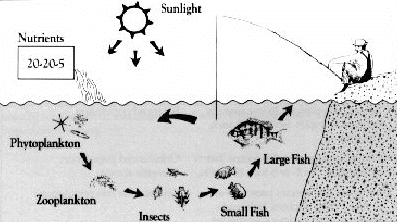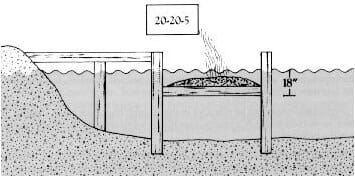 |
||||
Chapter 3: Pond Management
Liming
Some ponds benefit from the occasional addition of lime. Ponds with very soft, acidic water (less than 20 parts per million total alkalinity) will not be very productive, and also may not respond to fertilization, unless they are limed. Ponds with acidic waters (water having a low pH value) are common in many areas of North Carolina. Fishing will be poor if the pH is below 6.0. A pH value between 6.5 and 9.0 is considered optimum for fish ponds.
Water pH and alkalinity can be measured with inexpensive water testing kits available from most swimming pool supply stores. Or, you can send a water sample to the North Carolina Department of Agriculture Water Testing Laboratory (919-733-2657) for analysis, for a small fee.
However, a soil test from the NCDA Soil Testing Laboratory is the best way to determine how much lime your pond needs. For existing ponds, collect soil from 8 to10 areas throughout the pond from a boat using a can on the end of a pole. Mix the sample thoroughly, and allow it to dry. Then place the sample in a shipping box available from your county Cooperative Extension Center, label it as a pond sample, and mail it. The soil analysis you receive will indicate how much lime your pond needs. As a general rule, about one ton of agricultural lime per acre is required to raise the pH one point.
The lime should be distributed as evenly as possible over the entire pond. A common method for applying lime is to shovel it or wash it from a plywood platform while moving around the pond in a boat. Late fall or early winter is the best time to apply lime. A typical pond requires retreatment with lime every 3 to 4 years, although ponds with high rates of inflow and outflow require more frequent applications.
New ponds are easiest to lime while they are still empty. Before the pond is filled collect soil samples for analysis following the procedure described above. Lime, if required, can be spread over the bottom of the pond and disked in before the land is flooded.
Hydrated or builder's lime (calcium hydroxide) is generally not recommended, as it is caustic and has the potential to increase pH too quickly, killing the fish. If fish are not present or if agricultural lime is not readily available, hydrated lime can be applied carefully at the rate of 50 pounds per surface acre. Retreatment every few months is often required with hydrated lime.
Fertilization
As with land and crops, the fertility of the water determines the productivity of a pond. A typical pond supports 100 to 150 pounds of fish per acre. Fertilization can double or triple this production by stimulating the growth of microscopic plants (phytoplankton) and animals (zooplankton), which comprise the base of the food chain (Figure 8). These organisms are fed upon by insects and small fish, which provide forage for larger game fish.
Pond fertilization can, however, have negative side effects. Excessive fertilization can create noxious algal blooms. In addition, the decomposition of dead algae during summer months can cause low oxygen levels, which may cause fish kills during extended periods of cloudy weather.

Fertilization is an advanced pond management option that definitely is not recommended for everyone. Ponds that are naturally fertile, have high flow rates, or don't get heavy fishing pressure should not be fertilized. Fertilization can increase productivity, but it takes time and money, and has to be done right to avoid problems.
As a general guide, you can determine whether fertilization may be beneficial by the water clarity. If a light-colored or shiny object, such as your hand or a small (6-inch) pie tin or lid can be seen clearly 18 inches under water, fertilizing is an option.
Before beginning a fertilization program, measure the pH and hardness of the water, or have the pond mud analyzed, as described above. Ponds with alkalinity below 20 parts per million usually don't respond to fertilization, and need to be limed first. Apply lime at least 2 weeks (preferably several months) before fertilization. For many ponds, liming as necessary may support adequate pond productivity without fertilization.
Once begun, fertilization should be continued from year to year. Discontinuing fertilization will affect fish populations by reducing the food supply and will encourage the growth of filamentous algae and other undesirable aquatic vegetation. It is better not to fertilize at all than to do so in a random manner. Do not fertilize ponds that have extensive shallow areas. Do not apply fertilizer to ponds with weeds already present, as the fertilizer will promote weed growth and compound the problem.
Begin fertilization in spring when water temperatures reach 60F. Because ponds differ greatly, the number of applications of fertilizer needed per year cannot be predicted. Usually two to three applications, spaced two weeks apart, are required for a plankton bloom (greenish color) to develop. After the initial application, apply additional fertilizer whenever water clarity exceeds 18 inches to maintain a bloom until late summer or fall.
Fertilization may not be effective in ponds with high flow rates, muddy water, or stained water. If a bloom does not develop after the third application, consult a biologist.
Several types of liquid, soluble powder, and granular pond fertilizers are available. Most agricultural fertilizers do not have the best combination of nutrients for ponds. They include components that are unnecessary and may stimulate an undesirable type of algae. The following types of fertilizers and application rates are recommended:
| Type | Application Rate |
|---|---|
| water soluble powder (10-52-4, 12-49-6) | 4 pounds per acre |
| liquid (10-34-0) | 1 gallon per acre |
| granular (20-20-5) | 40 pounds per surface acre |
Generally, water soluble powder and liquid fertilizers are the easiest to apply and most economical. Soluble powder fertilizer requires the least labor because it goes into solution immediately and can be applied directly to the pond without mixing with water first. Because liquid fertilizer is heavier than water, it should always be mixed with water (one part of fertilizer to five parts of water) before application. It is best to siphon or pour diluted liquid fertilizer from a container while moving over the pond in a boat. If this method cannot be used, the diluted fertilizer can be sprayed or splashed around the edge of the pond, although this sometimes encourages the growth of undesirable algae and weeds. Do not use liquid fertilizers having a petroleum base.
Granular fertilizer should be spread on a platform 12 to 18 inches below the surface (Figure 9) so that it will be dissolved and dispersed by water currents. The platform should be located 10 to 15 feet from the bank. In watershed ponds it should be placed in the upper two-thirds of the pond, away from the drainpipe. For ponds of 3 acres or less, a platform with 9 square feet of surface area is adequate, whereas ponds of more than 3 acres require 3 1/2 square feet per acre. Ponds up to 10 acres can be fertilized with one platform.

Granular fertilizer can also be mixed with water and spread around the pond from the bank or by boat into water 5 feet deep or less. However, this type of fertilizer is most effective when it is not applied directly to the pond bottom because chemicals in pond mud can bind the nutrients, and fertilizer on the pond bottom can encourage weed growth.
Supplemental Feeding
Supplemental feeding can be used to increase the growth of fish and harvesting rates of ponds. Feeding is not necessary for most ponds, as an adequate quantity of natural food organisms (insects, worms, and crustaceans) are present to support fish populations. In small, infertile ponds, supplemental feeding may be preferable to fertilization for increasing productivity. Feeding is not recommended for fertilized ponds.
Bluegills and channel catfish will readily take feed, whereas bass usually do not. However, some commercial hatcheries sell "trained" bass that have been conditioned to consume artificial feed.
Feed only between spring and fall when the water temperature exceeds 65F. Stop feeding if the water temperature is greater than 90oF, as fish will generally not feed at higher temperatures. It is best to place the feed in the pond daily at several locations. Feed only the amount that the fish consume in about 10 to 15 minutes and no more than 10 pounds per acre per day. Excessive feeding can cause fish kills because the decomposition of uneaten feed depletes the oxygen supply. Discontinue feeding if the fish stop accepting the feed. Automatic and demand feeders are commercially available.
Be sure to continue a feeding program once you have started it. If feeding is discontinued while the fish are still accepting feed, there may be more fish than the natural food supply can support, resulting in stunted fish of poor quality. Occasional feeding will do little to increase fish growth.
Several commercial feed preparations are available in either floating or sinking varieties. Although more expensive, floating feed makes it possible to observe the extent and duration of feeding. Floating feed can be placed in floating plastic rings that prevent the pellets from washing ashore. Moldy feed should not be used, as it can be toxic to fish.
Habitat Improvement
Various devices can be used in ponds to concentrate fish and improve fishing. Best results are obtained in ponds that are devoid of natural cover such as stumps, tree tops, and aquatic vegetation. The devices should be located within casting distance of the shoreline or piers. Floats can be used to mark the location of the devices.
Brush Piles. Any available woody material can be used to make a brush pile. Again, the more vertical the pile, the better. Cedar and discarded Christmas trees can be set into cement blocks, secured with polypropylene rope, and set upright on the pond bottom. Several trees located together work better than single trees. Brush piles generally have to be replaced every few years.
Stake Beds. Any type of wooden stakes can be driven into the pond bottom or nailed to a weighted frame and sunk. The stakes should be placed 6 to 8 inches apart, and the bed should cover an area of about 200 square feet. The stakes should extend from the shoreline into water that is from 6 to 8 feet deep. The tops of the stakes should extend out of the water so they can be located easily. Pieces of plastic pipe can also be used as stakes.
Automobile Tires. Tires can be used to construct a satisfactory permanent structure, but they must be prepared properly. First slit them to allow them to sink and prevent them from floating around the pond. Then tie them together with polypropylene rope to keep them in position. Adding one or two cement blocks to the bundle will help stabilize it. The higher the structure is above the bottom of the pond, the more cover it will afford. Pyramid-shaped bundles are commonly used. Tires tossed in a pond at random will either wash ashore or silt in and provide no fishery benefits. Tires can be covered with brush to further increase their attractiveness to fish.

